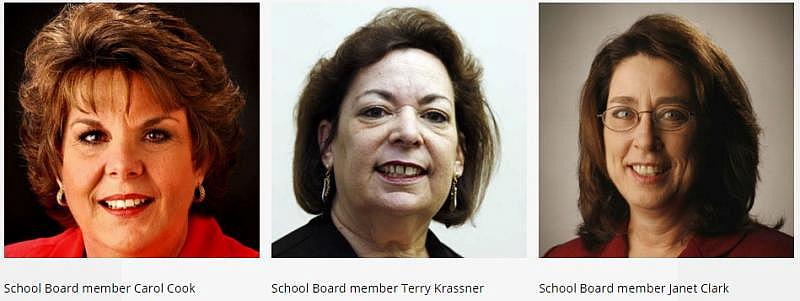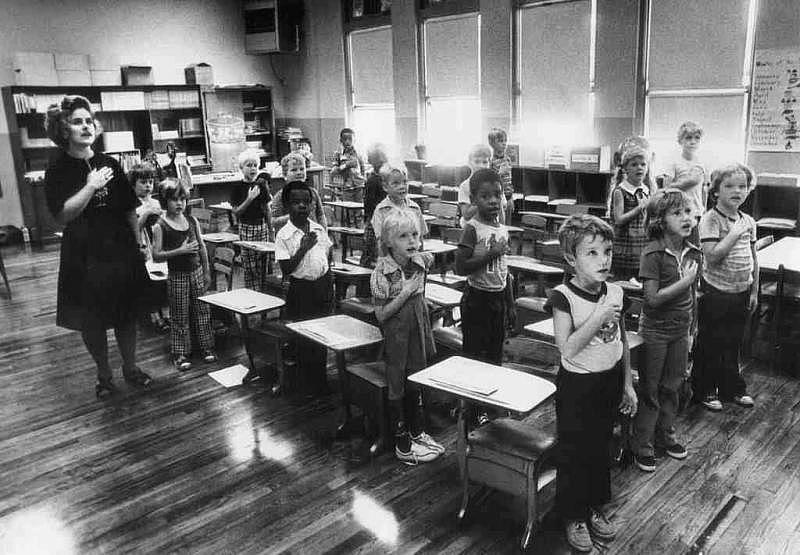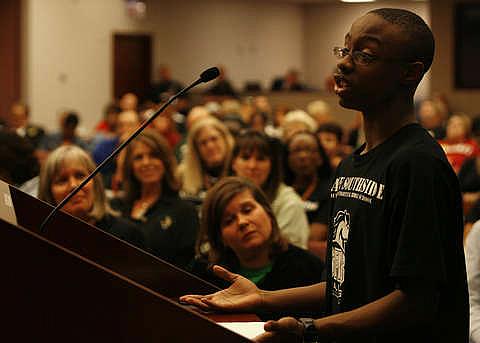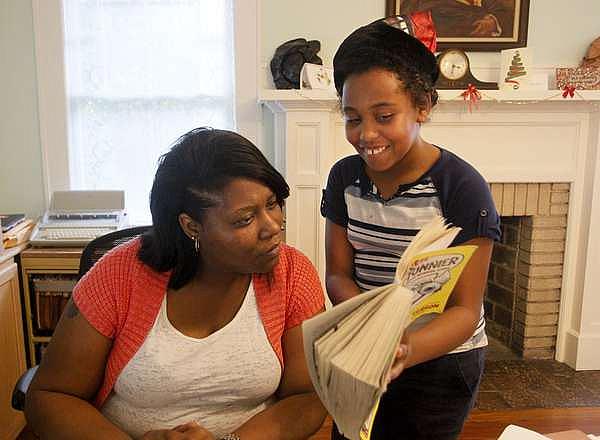'Failure Factories': Fundamentally unequal
Michael LaForgia wrote this story for the Tampa Bay Times as part of a 2015 National Health Journalism Fellowship.
Other stories in the series include:
How the Pinellas County School Board neglected five schools until they became the worst in Florida
Black leaders say district broke promises made to settle lawsuit
Confederate flag punctuates Pinellas School Board discussion on failing schools
In one Florida county, a skyrocketing failure rate for black children
'Failure Factories': Duncan blasts Pinellas school system for 'education malpractice'

When Madeira Beach Fundamental K-8 was located in St. Petersburg, it was 25 percent black. Today, blacks make up just 2 percent of the school’s students.
By Cara Fitzpatrick and Michael LaForgia
Just seven years ago, a black neighborhood in St. Petersburg was home to the most sought-after public school in Pinellas County.
Southside Fundamental Middle had students of all races lining up to get in. It boasted a perennial A-rating, some of the district’s most experienced teachers and one of the best bands in the state. And it all was within easy reach of the county’s black children, who made up more than 26 percent of Southside’s students.
Then the School Board shut it down, citing cost, and moved it to one of the whitest neighborhoods in the county.
This fall, there were 1,394 students at the relocated school, now called Madeira Beach Fundamental K-8.
Thirty were black.
Widely viewed as the best schools in the district, fundamentals were originally billed in Pinellas as a way of integrating the school system.
But over the years, School Board members voted for a series of school closures and policy changes that have made it harder for black children to get into the schools — and largely transformed fundamentals into places for affluent white families.
Today, a Tampa Bay Times investigation has found, more black children are applying to fundamental schools than ever before, but black enrollment at the schools is at an all-time low.
Blacks make up about 19 percent of both the student population and fundamental school applicants.
Yet they are only 12 percent of students attending the schools.
Their share of the total enrollment has been cut in half since 2005, when 25 percent of fundamental school students were black.
In an interview last month, Pinellas school superintendent Mike Grego said he didn’t believe the district’s fundamental school system is inherently biased against black children. “The St. Petersburg community is about 39 percent African-American, and our schools in St. Petersburg are about 35 percent, 36 percent African-American,” Grego said.
But he acknowledged the district could make the schools more accessible and said he would review admissions policies to ensure fairness. “Everything is on the table,” Grego said. “Our board is very proactive in this area.”
Reached by the Times, a majority of School Board members said making changes to the county’s fundamental school system is a low priority, and they are largely satisfied with how it works today. Several questioned why reporters were even asking about it.

“I’m not a huge believer that having a black, Hispanic and white student sitting together improves education,” said Carol Cook, a board member since 2000.
“I don’t like to think of it as one school is more special than another,” said Terry Krassner, elected in 2010. “It is what we make it.”
Only board member Janet Clark said the system discriminates against black children and students from poor families. Clark said she expects a backlash from some white families if the system ever changes. She said she has gotten messages with racist overtones from fundamental school parents. “I had a few emails that flat out said they didn’t want black kids,” said Clark, who joined the board in 2004. “We created a two-tiered system.”
Members of the black community point to test scores as a reason they want more access to the schools. State records show black children in fundamental schools are about 80 percent more likely to pass reading than black children in the district’s regular schools.
“There are parents that want their kids to get a quality education. And they are applying and not being able to get into these schools,” said Ray Tampa, a retired Pinellas school principal and former president of the St. Petersburg NAACP. “It’s a situation where the African-American students are always at a disadvantage.”
Built-in bias
Like magnet schools, fundamentals first emerged nationally in the 1970s as a way of driving voluntary integration. The idea was to make the schools so appealing that whites would choose to send their kids to school in black neighborhoods.
Initially popular in socially conservative areas, fundamentals are supposed to hearken back to the school houses of a bygone American era. Students have to follow strict rules and can be kicked out for even minor disobedience. Parents have to sign contracts pledging nightly reviews of their child’s homework and regular attendance at school meetings. If parents are deemed not involved enough, that, too, is grounds for being kicked out.
Pinellas opened its first fundamental in Clearwater in 1976. It had room for about 300 students. Children from anywhere in the county could apply. Admission was decided by lottery.
But unlike other school districts that were adding so-called “choice” programs across the nation, the Pinellas County School Board decided not to offer bus service to fundamentals.
Former administrators recall the reasoning.
“Many of us at my level were very much in favor of transportation,” said Linda Benware, who was director of magnets and special programs from 1990 to 1997. “But the argument was always that these students come from such a variety of neighborhoods that it would drive up the cost of transportation tremendously.”
No bus service meant parents who wanted their kids in fundamentals had to live near one of the schools or pay the cost of getting them there.
That policy continues today for seven of the nine schools, even though Pinellas offers busing to magnets and other special programs around the county.
When districts don’t transport children to choice programs, only families that can afford to get their kids to school can make choices outside their neighborhood, said Gary Orfield, co-director of the Civil Rights Project at UCLA and a leading expert on school segregation.
“A single-parent family with a working parent can’t typically do that,” he said.
In Pinellas, where 80 percent of black families live near the poverty line, that resulted in a racial bias.
Today, the county’s fundamental schools are largely populated by children from better-off, white families.
Across the county, 54 percent of all students are poor enough to qualify for subsidized lunch. At the nine fundamental schools, the rate of students on subsidized lunch is 24 percent.
“Choice can either make things more unequal or make them more integrated and equal.
It all depends on what policies are attached to the programs,” Orfield said. “Transportation is an absolutely key aspect of a fair choice system.”
Bad luck
The district’s no-bus service policy has frustrated parents like Tanisha Wooten.
A 37-year-old single mother, Wooten has struggled with unemployment and has sometimes had to stretch to pay the bills. But she wanted her three school-age kids to get the best education they could.
She entered them into the district lottery in 2010 and won seats for her daughter and older son at Madeira Beach Fundamental.
The good luck meant she would probably also get a spot for her younger son, Jaymir, when he got older, because siblings get preference in enrolling at fundamental schools.
Every morning for three years, Wooten piled the kids into her 10-year-old Nissan Maxima for the half-hour ride to school.
Then, in 2013, the car’s transmission went out.
Unable to drive her children to school, she had to pull them out and find closer options.
“I hated to have to take them out of there,” Wooten said. “Some people don’t have transportation, but they still want the best school for their children.”
Her daughter moved on to high school. Wooten eventually got her son Jaylon into Lakeview Fundamental Elementary near their house.
Pinellas County’s first fundamental students in 1977.
But his younger brother Jaymir wasn’t so lucky. His name wasn’t drawn in the lottery that first year. He had to go to Lakewood Elementary, currently one of the worst-performing schools in Florida.
With one child in a fundamental and the other in a failing neighborhood school, Wooten said the differences were “incredible.”
Ten-year-old Jaylon rarely faced disruptions in class. Seven-year-old Jaymir had to navigate one of the most violent schools in the district. Jaylon’s teachers and principals were in regular contact with Wooten. Jaymir’s never made an effort.
The other children at Lakewood relentlessly picked on Jaymir. At lunch, he would sit in the classroom with his teacher rather than mingle with the bigger kids who bullied him.
Finally, after a difficult year, Jaymir won his own seat at Lakeview Fundamental in fall 2015.
He’s already benefiting, Wooten said.
“He’s being challenged,” she said. “It’s a huge difference.”
Decision points
When the county’s first fundamental opened in 1976, seats were given out on a first-come, first-served basis. Fifteen percent went to black children, in keeping with a court-ordered racial quota in force at the time.
For 20 years after that, the enrollment process stayed roughly the same.
By the 1990s, parents of all races were clamoring for the fundamentals because they offered structure and because children who got into fundamentals weren’t subject to court-ordered busing to random schools outside their neighborhoods.
The district had four fundamental elementary schools and one middle school, and 24 percent of the students were black.
Then board members made a series of unrelated decisions that benefited white children and added up to fewer black children getting in.
They voted in 1994 to give preference to siblings of students already enrolled and to the children of teachers who worked at the schools. A large majority of fundamental students and teachers were white, so this reduced chances for others.
They opened a fundamental middle school near Clearwater in 1995 rather than continue requiring white families from north county to send their children to Southside in St. Petersburg.
On two occasions they closed fundamentals in black neighborhoods and moved them elsewhere in the name of saving money.
Rather than pay to repair the interior of mold-damaged Childs Park Fundamental Elementary in the heart of St. Petersburg’s black community, they closed the school in 1995 and reopened it in Pasadena Elementary near the Gulf of Mexico — in an area that is 90 percent white.
Facing a budget crunch and an aging Southside Fundamental Middle in 2009, they closed that school and moved it 12 miles away to wealthier, mostly white Madeira Beach.
Then, after moving those schools out of black neighborhoods, board members enacted a major policy change: they voted in 2010 to give families living nearest to fundamental schools priority in the admissions process.
The combined effect reshaped the fundamental school system in ways that made it harder for black children to get seats.
Falling enrollment
In a district of 101,415 students, there are 7,095 seats in fundamental schools. But only about 2,000 are up for grabs in a given year.
Before children even can vie for a spot in a districtwide lottery, hundreds of seats are taken up through preference policies that favor white families.
Children of teachers at the schools — where instructors are 93 percent white — get first crack.
The next round is reserved for siblings of children at the schools, which are nearly three-quarters white.
Next, seats go to children based on how close to the schools they live. Six of the nine schools are located in predominantly white neighborhoods.
At this stage in the admissions process, there are typically about 1,000 seats left, and more than 9,800 applications competing for them.
There were 960 black students enrolled in fundamental schools in 2005. Today, there are 842 black children at the schools. That’s 118 fewer black children even though the district has expanded fundamentals by 3,200 seats in the past 10 years.
At the same time, the number of seats claimed by whites and Asians has multiplied. They had 2,622 fundamental school slots in 2005. In 2015, they had 5,409 seats, or 76 percent of all available openings.
Southside Fundamental Middle student council president Lorenzo Bright pleads with the School Board in 2008 not to close his school.
Black children lost the most ground in the six fundamental schools surrounded by mostly white neighborhoods.
They were 25 percent of all students at Pasadena Fundamental Elementary a decade ago. They are just 5 percent of that school’s students today.
They were 20 percent of all students at Curtis Fundamental Elementary in Clearwater in 2005. They are 5 percent of total students today.
At the three fundamentals in black neighborhoods, black enrollment has largely stayed flat at about 35 percent.
Whites and Asians gained seats in the system when the School Board converted Osecola High School into a fundamental and expanded slots at Clearwater Fundamental Middle.
But the biggest spike in their enrollment came when the School Board moved Southside Fundamental Middle to Madeira Beach in 2009.
The school closure profoundly affected the black community’s access to fundamental schools.
Even after district leaders added seats to Thurgood Marshall Fundamental Middle, which had opened in south St. Petersburg a few years earlier, the move took about 400 fundamental school seats away from the city’s black neighborhoods.
A program that once brought white students into black neighborhoods is now largely operating in white communities.
Out of place
Most said they were happy their children went to the schools.
Lafara Wright, 39, said her daughter Laneise is flourishing as a third-grader at Bay Vista Fundamental Elementary. “I wish all schools were fundamentals,” she said.
But all of the families told the Times they wished the schools were more diverse.
Some described feeling uncomfortable in schools that have gotten whiter and more affluent over the years.
TaQuaisha Johnson, 34, is determined to keep her daughter, Maliyah, at Pasadena Fundamental Elementary.
TaQuaisha Johnson sends her daughter, Maliyah, to Pasadena Fundamental Elementary, where the fourth-grader is one of 22 black children in a school of 460 students.
When Johnson first enrolled Maliyah at Pasadena five years ago, she recalled feeling out of place amid the doctors and businesspeople with children at the school.
“We felt like we were being closely watched,” said Johnson, a 34-year-old paralegal at a St. Petersburg law firm. “But we made it up in our minds. We’re going to stay there and prove African-Americans can make it in the fundamental school system.”
A few families told the Times they felt like children are treated differently at the schools because they are black.
Retired educator Doris Newton said her grandson, Jakare Carroll, was singled out for discipline at Bay Vista Fundamental Elementary in a way that his classmates of other races were not. She said his teachers and principals simply wanted him out of the school. “I felt like it didn’t matter what he did,” Newton said of Jakare, now 14 and attending a neighborhood school. “They were working toward getting him out.”
Lashanda Church said her son, 6-year-old Josiah Dean, also seemed targeted for discipline at Bay Vista Fundamental.
She acknowledged that the kindergartener was misbehaving last year, but she said there was a good explanation: his father, 37-year-old James Dean, who would get Josiah ready for school every morning, was shot to death in an argument two months into the school year.
Right away, she said, Church told the school about her husband’s murder and asked for understanding if Josiah seemed to be having a hard time.
Instead, Church said, his teacher and principal began punishing Josiah harshly even for minor infractions. They wrote him up for “defiance” in February.
A month later, they gave him out-of-school suspension for “striking an adult.” He told his mother he became frustrated and kicked his teacher’s desk.
He got written up a third time in April for “repeated misconduct,” and the principal called a conference with Church to talk about Josiah’s future.
“It was like, ‘Give me a break,’ ” Church said. “He was just going through a lot, and every time I turned around he was getting written up.”
They called Josiah before a committee of parents and teachers and put him on probation, telling Church he would be kicked out for good if he got in trouble again.
Unsettled at the thought, Church, a 39-year-old nursing assistant, left work early and juggled shifts to visit him at school during the day.
With her help, he made it through the last month without being written up again. He started first grade at Bay Vista Fundamental this year. So far he’s avoided getting in trouble, his mother said.
No place to turn
Church was so desperate to keep Josiah at the fundamental because the alternative was Lakewood Elementary, the 12th worst elementary school in Florida as ranked by the Florida Department of Education.
For many parents in south St. Petersburg who can’t afford better options, fundamentals and other special programs are like a lifeline that remains just out of reach.
They’re the only alternatives to the perennially failing neighborhood schools — Campbell Park, Fairmount Park, Lakewood, Maximo and Melrose.
Yet fundamentals also make problems in the failing schools worse by siphoning away the most affluent and involved families.
Two of the schools, Lakewood and Maximo, might be different places if fundamentals weren’t drawing students away from them. Lakewood, with an enrollment of about 450, lost 176 kids to fundamental schools this year alone. Maximo, with about 360 children, lost 157.
The children left behind have to contend with the worst of everything in the district, the Times series, “Failure Factories,” has shown. The most violence and disruptions. The least experienced teachers. The harshest discipline for minor misbehavior.
“If you can’t make it at one of the elite programs, they’re going to get you routed to a Fairmount or a Melrose,” said the Rev. James Holt, a St. Petersburg pastor whose grandson struggled at Fairmount Park before moving to another county. “And then, before you know it, Melrose and Fairmount have all the children who have behavior problems.”
With few prospects for getting their children someplace better, parents like Anthony Harris are forced to get in line and wait. They enter the lottery and lose. Enter it again. And again after that.
Harris’s daughters, Princess, 9, and Isabella, 8, are trapped at Lakewood Elementary.
Harris said he has applied for fundamental schools every year since moving his family here from North Carolina about three years ago, and every year he has lost out.
The longer the process takes, the more anxious he gets. Just weeks into this school year, Princess came home with one side of her face red and swollen. She had been hit in the eye at Lakewood by a thrown book.
He said he didn’t want to send her back after that. But he didn’t have a choice.
[This story was originally published by the Tampa Bay Times.]
Photographs by Dirk Shadd/Tampa Bay Times.

